The Barcelona metro is modern, efficient and easy to use. Trains run frequently throughout the day, and you seldom have to wait more than a few minutes.
This article contains all the information you need to help you get around the city, including maps, timetables, tickets and more.
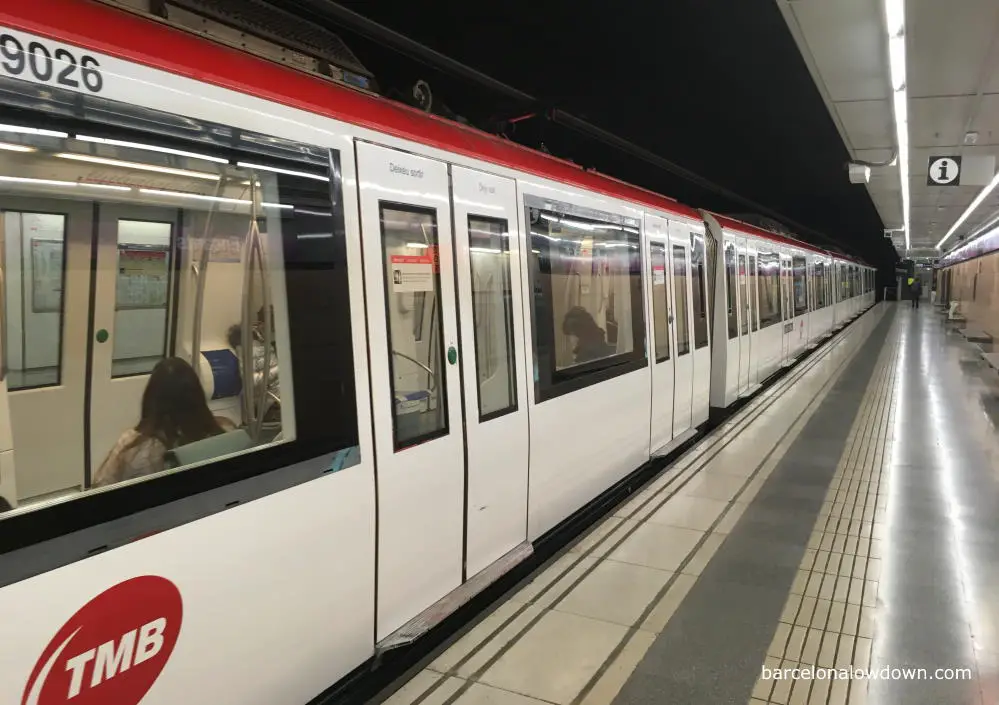
Contents
Barcelona Metro lines and maps
Barcelona’s metro system comprises 161 stations connected by ten lines which cover the entire city. The metro is linked to the railway network and there are metro stations at both terminals of Barcelona airport.
There are maps at the entrance to all metro stations as well as in the vestibules, on the platforms and inside the trains.
The map is colour coded, and the colours also appear on signs within the stations and on the platforms. In this article, and throughout the website, I refer to both colours and line numbers.
Download a free PDF map of Barcelona metro here >>

Route planning
Over the years, I’ve tried several different apps and websites and prefer Moovit, which is available for Android and iOS.
Alternatively, there’s a route finder on the TMB website. Google maps also works well in Barcelona.
Barcelona Metro timetable & opening times
Departures vary throughout the day, at most times trains depart every five minutes.
| Day | Time |
|---|---|
| Mon – Thurs | 05:00 – 24:00 |
| Friday | 05:00 – 02:00 |
| Saturday | 05:00 – 24:00 |
| Sunday | 24 Hours |
| Public holidays* | 05:00 – 24:00 |
| 24 December | 05:00 – 23:00 |
* The night before public holidays, the metro often runs through the night.
If you are at a stop further along the line, the last train may depart ten or even twenty minutes later.
Barcelona metro zones
Barcelona’s public transport system is organised into six zones. The city of Barcelona and the entire metro system are within zone one.
Zones two to six cover surrounding towns and cities and extend as far as Blanes, Vic, Manresa and Calafell.
If you are visiting towns outside Barcelona, check out this article about Barcelona travel zones.
Tickets and travel passes
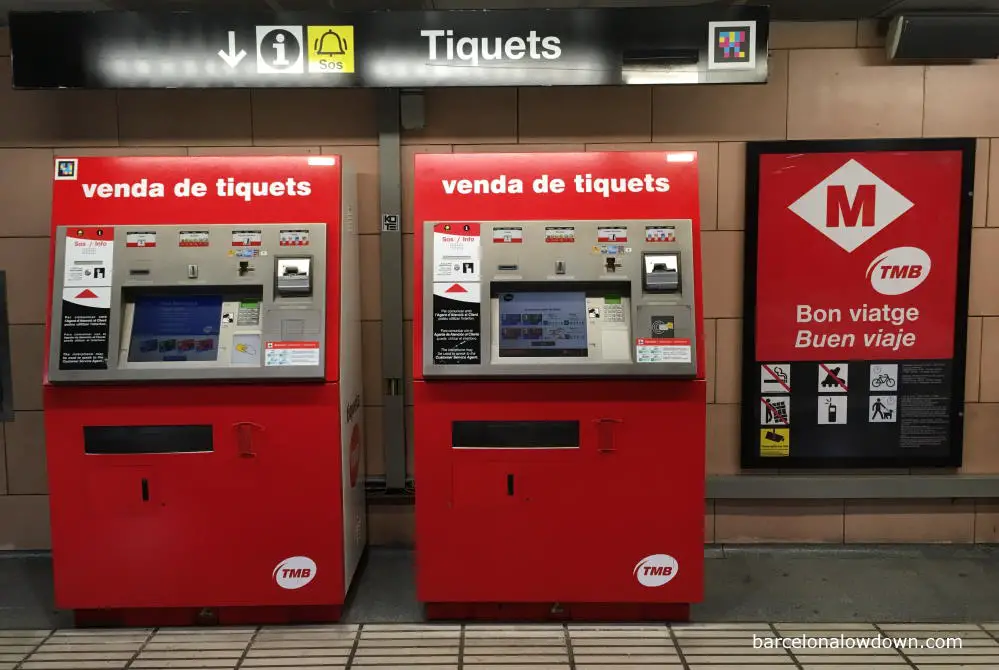
There are a lot of different tickets and travel cards available for the Barcelona metro. In this post, we take a look at the most suitable ones for tourists and people visiting for a few days.
Single metro ticket
Single metro tickets currently cost €2.40 are valid for one journey.
Single tickets allow you to transfer between different metro lines as part of the same journey, as long as you don’t leave the station or pass through the ticket barriers.
If you leave the station and re-enter, you will have to purchase another ticket. Single metro tickets don’t allow you to transfer to other modes of transport (tram, bus, train etc.)
Single airport metro ticket
The airport metro costs €5.15 each way. If you mistakenly arrive at the airport metro station with a standard single metro ticket, you will have to purchase an additional ticket to leave the station.
Hola Barcelona travel card
The Hola Barcelona travel card is aimed at tourists and offers unlimited travel on the Barcelona metro, including the airport metro.
It also covers TMB buses, tram, the Monjuïc funicular railway and commuter trains operated by RENE and the FGC within zone 1.
Four different cards are available valid for 48, 72, 96 and 120 hours from their first use.
| Duration | Price |
|---|---|
| 48 hours | €16.30 |
| 72 hours | €23.70 |
| 96 hours | €30.80 |
| 120 hours | €38.00 |
Find out more and purchase your Hola Barcelona card here >>
T-día
The T-día allows unlimited journeys on the ATM integrated transport system for 24 hours from its first use. It can be used to travel on the metro, including the airport metro, commuter trains (operated by RENFE and FGC), trams, and TMB buses.
Unlike the Hola Barcelona Card, which only covers zone 1, the T-día can cover from one to six zones, and the price varies accordingly. A 1 zone T-día costs €10.50.
T-casual
The T-casual is valid for ten journeys and allows you to transfer between different modes of transport within one trip. A 1 zone T-casual costs €11.35.
The T-casual be used to travel on the metro, commuter trains (operated by RENFE and FGC), trams, and TMB buses but is NOT valid for the airport metro.
T-familiar
Unlike the other transport passes mentioned here, the T-familiar can be shared by up to eight people travelling at the same time.
The T-familiar is valid for eight journeys and allows you to transfer between different modes of transport within one trip. A 1 zone T-casual costs €10.00.
It can be used to travel on the metro, commuter trains (operated by RENFE and FGC), trams, and ATM buses. The T-familiar is NOT valid for use on the airport metro.
Discount Cards and Sightseeing Passes
There are several different sightseeing and city passes available in Barcelona, some of which include free public transport.
If you are thinking of purchasing a travelcard or sightseeing pass, I recommend you read this post >>
Travelling by metro
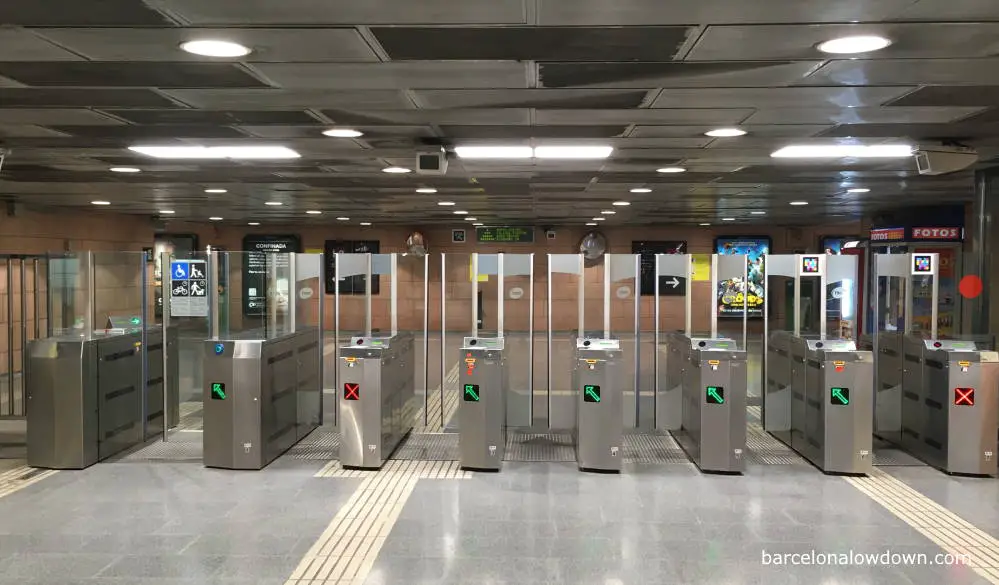
Metro stations
All of Barcelona’s 161 metro stations are located underground, a few of them are connected to train stations. At street level, the stations are marked by signs with the familiar red and white “M” logo.
As you enter the station, a sign above the door indicates the stop’s name and which metro line(s) stop there. Most stations have two or more entrances, usually with steps down to the vestibule and escalators back up to street level.
Outside the station there is also a map of the metro system and, at most stations, one of the entrances will have a glass elevator down to the vestibule.
Once inside the metro station, they are all laid out similarly, although some are larger than others. Entering the station from street level, there is a hall with ticket vending machines, maps of the metro system and ticket barriers giving access to the trains.
How to purchase metro tickets
Ticket machines at the station accept cash (coins and notes) and cards. At a few of the larger stations, there are also ticket offices staffed by TMB personnel.
The ticket machines accept most European credit and debit cards (Visa and Mastercard), but I’ve been told that some non-EU credit cards don’t work. If your card doesn’t have a chip and a four-digit PIN code, you won’t be able to use it to purchase tickets from the machines.
Tickets can also be purchased via the TMB app, from some tobacconists and online.
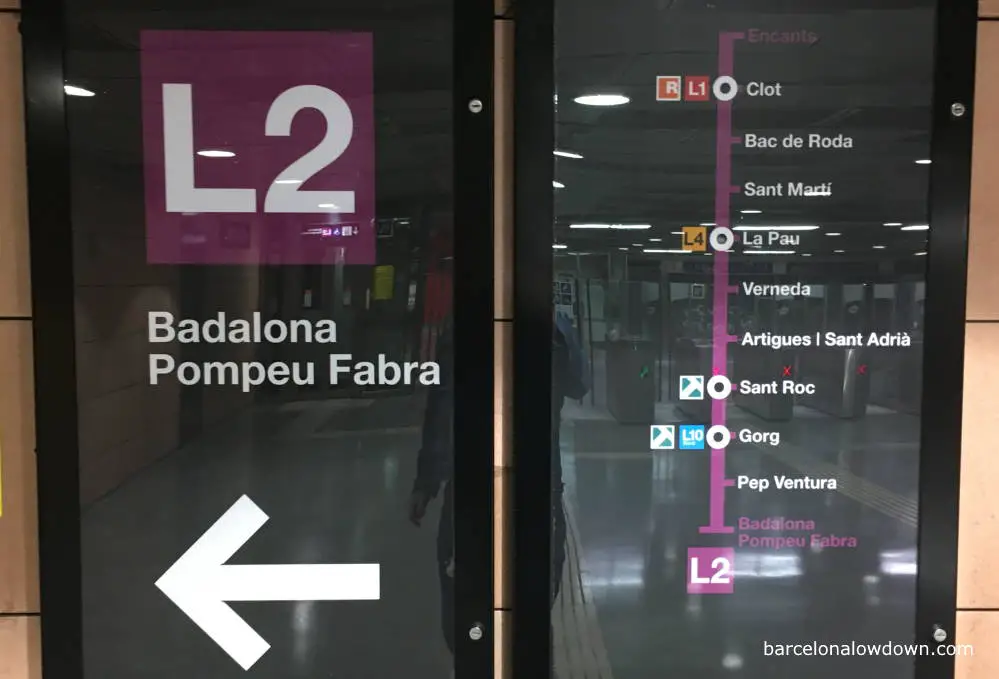
Ticket barriers
Access to the trains is through a row of automatic ticket barriers similar to those shown in the photo above.
To open the barrier you insert your ticket into the slot at the front of the barrier, it then passes through the machine where it is checked, validated and stamped before exiting through the slot at the top of the barrier.
As you remove the ticket from the top of the barrier, the glass gates slide open to let you through. A green LED arrow below the slot where you inserted the ticket indicates which gate will open. Red crosses mark the gates which are being used to exit the station. A few stations still have the older style metal turnstiles.
One of the barriers is adapted for people using wheelchairs or with pushchairs, as shown in the photo. Next to that, there is a metal gate which can be opened by station staff if needed.
Ticket inspectors patrol the stations and on the trains checking tickets. The fine for travelling without a valid ticket is currently €100.
Locating the correct platform
Once through the ticket barriers, there are stairs and lifts down to the metro lines. Colour coded signs guide you to the right platform.
In most stations, each platform serves one line travelling in just one direction. A sign at the top of the stairs shows which stations the train will stop after departing the current station.
Once on the platform, you’ll see a long sign which runs along the entire length of the platform. Located on the wall, just above head height, the sign includes the station’s name and a plan of the line.
The plan of the line is divided into two sections. The section which is marked in white represents the stations where the train has already stopped. The coloured section shows the stations which the train will stop at after leaving the current station. There are also arrows indicating the direction of travel.
Next train signs
Illuminated signs above the platform display the time remaining before the next train will arrive, its destination and the current time.
Boarding and alighting the trains
Upon arrival at the station, on some lines, the train’s doors open automatically. You should let passengers alight from the train before boarding.
On the lines where the train doors don’t open automatically, there are buttons or levers on the doors to open them manually. Please wait until the button is illuminated (indicating that it has been activated) before pressing the button to open the doors.
At peak times, the metro can get very busy. Generally speaking, carriages towards the middle of the trains tend to be less crowded since, in most stations, the stairs down from the vestibules are at the end of the platform.
Exit signs & street maps
Once inside the train, you’ll see red arrows at each end of the carriage which light up to show which side of the train you will be able to exit at the next station. If the train doors don’t open automatically, there are buttons or levers on the doors to open them manually.
As you alight from the train, look at the sign that runs the platform’s length to see where the nearest exit is located. Exits are marked by the word Sortida (Exit in Catalan). If there is more than one exit available, the corresponding streets’ names will also be indicated.
There are street maps on the platforms and in the vestibule to help you get your bearings and decide which exit is nearest to your destination. When leaving the station, the ticket barriers open automatically; you don’t need to insert your ticket again.
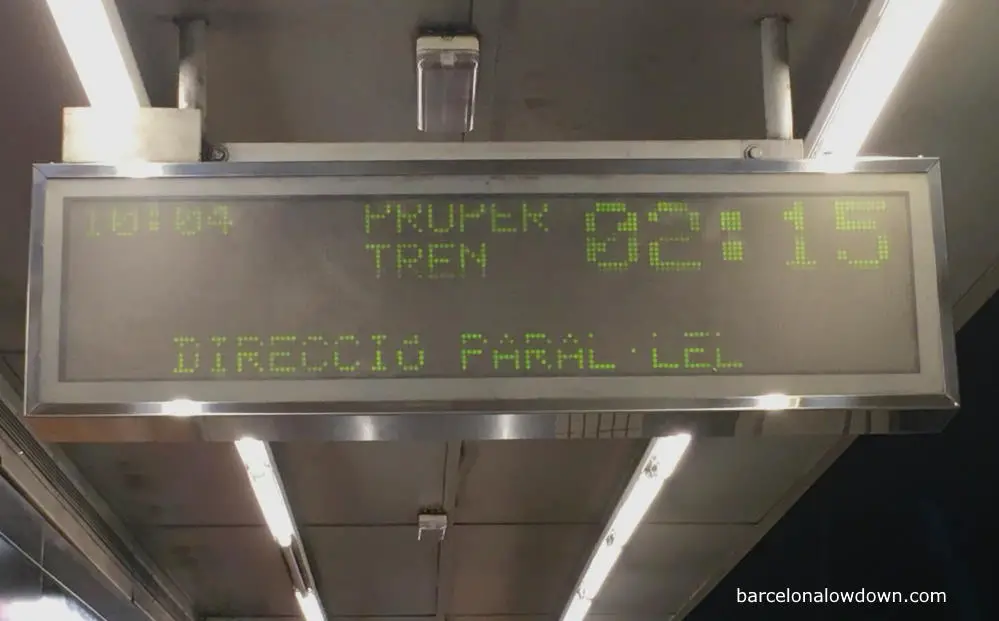
Help and assistance
There are information points located on all platforms with metro maps, street maps and an intercom that can be used to speak with station staff.
Wheelchair access & mobility scooters
Currently, 147 of Barcelona’s 161 metro stations are accessible to wheelchair users.
In most cases, there is a lift up to the vestibule from one end of the platform. In metro stations with platforms on both sides of the train, there may only be a lift on one of the platforms.
At stations which have been adapted for wheelchair users, there will be at least one lift between street level and the vestibule.
List of metro stations which haven’t been adapted yet
| L1 (red line) | Plaça de Sants | Espanya | Urquinaona | Clot |
|---|---|---|---|---|
| L3 (green) | Espanya | Vallcarca | ||
| L4 (yellow) | Maragall | Verdaguer | Urquinaona | Ciutadella-Vila Olímpica |
| L5 (blue) | Virrei Amat | Maragall | Verdaguer | Plaça de Sants |
Barcelona airport metro
The airport metro is currently the only metro line in Barcelona with crewless trains. There are stations at both terminals of Barcelona airport, and trains depart approximately every five minutes.
The L9 sud (orange line) runs from Barcelona airport to the University of Barcelona campus in the Les Corts district. It has 15 stops: Airport T1, Airport T2, Mas Blau, Parc Nou, Cèntric, El Prat Estació, Les Moreres, Mercabarna, Parc Logístic, Fira, Europa-Fira, Can Tries-Gornal, Torrassa, Collblanc, Zona Universitaria.
To get to the city centre, you have to change lines either at Torrassa or Collblanc. Depending on where you are staying in the city, you can expect the journey to take approximately 45 minutes.
The airport metro currently costs €5.15 each way.
If you plan to use the metro to travel from and to the airport, you should consider purchasing a Hola Barcelona Travel Card, which gives unlimited travel on the metro.
There’s more information about transferring to and from Barcelona airport in this post >>
Barcelona Metro FAQs
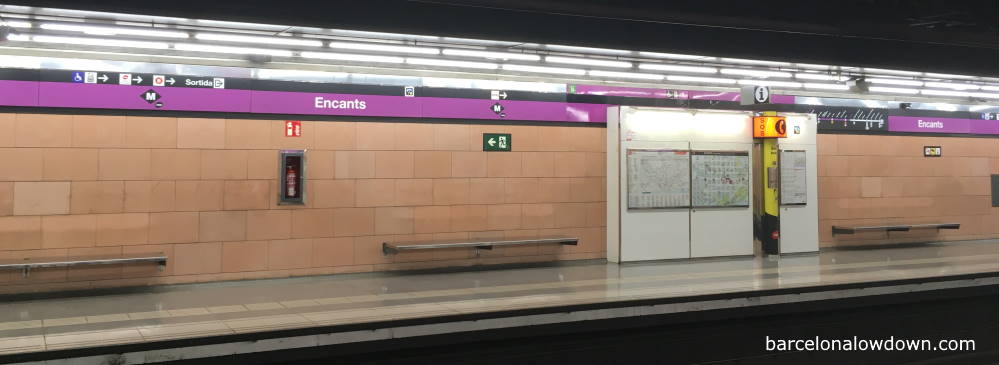
Does Barcelona metro run 24 hours a day?
Barcelona metro runs all night from Saturday to Sunday and during some public holidays. On Friday nights, it runs until 2 am. On weekdays and Sundays, the metro runs until midnight and then opens again at 5 am.
Does it matter which entrance I use when entering a metro station?
In most metro stations, it doesn’t matter which entrance you use. Once underground, the main hallway gives access to all platforms.
The only exception is Liceu which is on the L3 (green line). The Liceu metro stop has two entrances, one for each platform. The only way to change between platforms is by leaving the station and returning to street level.
Before going through the ticket barriers at this station, you should check the signs to ensure that you are entering the correct part of the station.
Can I take the metro up to Montjuïc?
The Montjuïc funicular railway connects to the metro system at the Paral·lel metro stop on the L3, green line. Signs and pictograms in the station direct you to the funicular.
If you visit the MNAC, Magic Fountain, Poble Espanyol, Palau de Sant Jordi or the Miró Foundation, it’s best to take the L3 (green line) or L1 (red line) to Espanya. From here you can either walk or catch bus number 150. Bus number 150 also stops at Montjuïc castle and the upper funicular station.
Can you use a metro ticket on the bus in Barcelona?
Single metro tickets can not be used to travel on buses in Barcelona. However, numerous travel passes do allow you to transfer between metro, bus, tram and commuter trains as part of the same journey. For example, the Hola Barcelona travel card offers unlimited travel on the metro, tram, commuter trains and TMB buses (except the night bus).
Does the ticket for the Aerobus include the metro?
The Aerobus is run by an independent company and isn’t part of the ATM system. When transferring from the Aerobus to the metro, you have to purchase separate tickets, one from the Aerobus and another for the metro.
Does the airport metro ticket allow me to transfer to another line?
If you purchase a ticket for the airport metro, as long as you don’t go out through the ticket barriers, you can transfer to another metro line as part of the same journey.
Is the metro safe in Barcelona
Barcelona is a very safe city, but unfortunately, like many other large European cities, it does have a problem with pickpockets in crowded public places. When travelling on the metro, you should take care of your belongings and be aware of what’s going on around you.
Is the Barcelona metro easy to use?
The Barcelona metro is very easy to use, the stations are well signposted, and there are separate platforms for each line, making it unlikely that you will get on the wrong train.
Are there child fares for the Barcelona metro?
There aren’t child fares on the Barcelona metro, and children aged four years and upwards pay full fare.
Children under four travel free of charge and don’t need a ticket.
The T-Jove is a travel pass for young people (under 25), which is valid for three months, but it’s quite expensive and isn’t usually worth buying for short stays.
Can you take dogs and cats on the Barcelona Metro?
Dogs and cats are allowed to travel on the metro in Barcelona, although there are some limitations. Cats must be transported in a cat carrier. Dogs which have been chipped may travel on the metro except for peak times; Mon – Fri, 07:00 – 09:30 & 17:00 – 19:00.
When travelling on the metro, dogs must be kept on a leash and wear a muzzle. Dogs must be supervised by an adult (one adult per dog) and cannot use the escalators. Dogs may not occupy a seat and should not obstruct the doors.
Guide dogs are exempt from the above restrictions and may travel on the metro at any time.
Can you transport bicycles on the metro in Barcelona?
Bicycles may be taken on the metro except for peak times; Mon – Fri, 07:00 – 09:30 & 17:00 – 20:30. During July and August, bikes can be transported at any time.
Folding bikes are exempt from these restrictions and may be transported on the metro at any time as long as they are folded up and don’t cause an obstruction or inconvenience, other travellers.
Are skateboards and scooters/electric scooters allowed on the metro?
You cannot use skateboards or scooters in the metro, neither in the trains nor on the metro premises (platforms, passageways etc.).
However, you may transport skateboards and scooters on the metro as long as they don’t cause an obstruction or inconvenience, other passengers.
Electric scooters are currently banned from public transport in Barcelona
In January of 2023, it was announced that electric scooters will temporarily be banned from all forms of public transport in Barcelona. The ban will take effect from February 1st until the 31st of August 2023. Apparently, the ban is due to the fact that there have been fires on trains caused by electric scooters with faulty batteries.
As always, if you have any questions or think I’ve missed anything, please leave a comment below.





Hi Richard,
I was mailing you earlier.
Can you tell me if the Aerport to Mataro and back is covered by the 3-zone T-familiar ticket.
Or do we need another ticket for aerport to city, then use the 3-zone T-familiar for the city to Mataro run. We will enjoy walking thru the city so wont need a zone 1.
Hi Derek,
Yes, from Barcelona Airport to Mataró by train using the route I described in my reply to your other comment is covered by the 3-zone T-familiar and counts as one journey (of the 8 on the ticket).
If you are arriving at terminal one you should use the free shuttle bus and not the airport metro to transfer to terminal 2 (where the train station is located) because the T-familiar is not valid for travel on the metro from the airport. The location of the shuttle bus stop is described in this post.
If you take the metro from terminal 1 to terminal 2 then you would have to purchase an additional ticket for the metro and, although it might save you a few minutes when compared with the shuttle bus, I don’t think it’s really worth it.
There are other combinations that you can make by taking either the airport metro or the bus to Plaça de Catalunya and then catching the train or bus from there to Mataró but they all work out more expensive and aren’t any quicker.
There is also a direct bus from the airport to Mataró but, at this time of year, there are only two departures per day and they don’t combine well with your flight.
Hello, thank you for this informative site. I’m having some trouble understanding. Could you please suggest which TMB ticket would be the best to purchase if I live in Xior Diagnol Besos and study at the University of Barcelona Business school? I FIGURED my best option must be the T-Usual. Is that correct? How many zones do I purchase for?
Thank you for your help!
Hi Rss sid,
It depends on how old you are and how long you will be staying in Barcelona. If you are under 25 and are staying for a few months, the 90-day T-Jove would be the cheapest option. If not then, as you say, the T-Usual would also be good value since it works out a little cheaper than the T-casual.
The Xior Student Housing Residence in Besos and the Pedralbes campus are both within zone 1 so, assuming that you only want to travel between these two sites and into the city centre, then you will only need a 1 zone travel card.